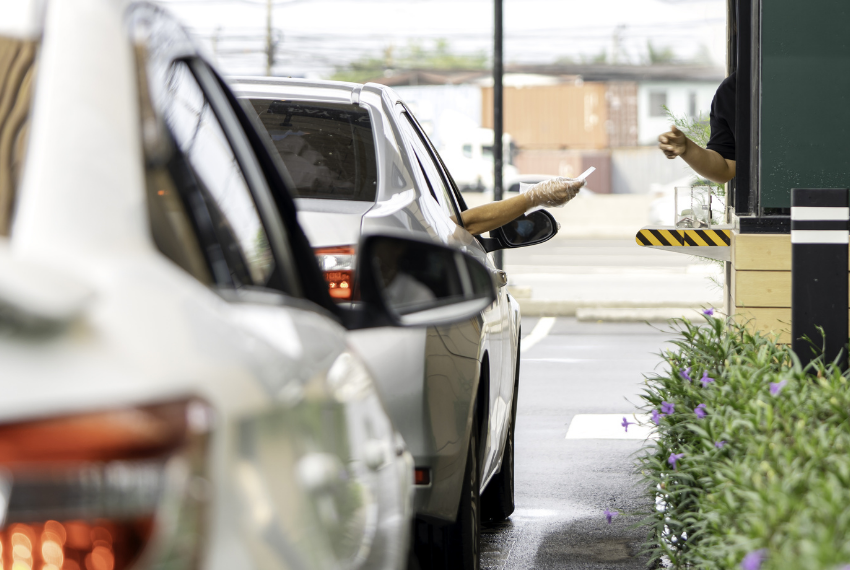Call Sales: +1 (833) 437-3835
Call Sales: +1 (833) 437-3835

America has a longstanding love affair with cars. Simply look to the national highway system, which accounts for 160,955 miles of asphalt as confirmation. But more than cars, Americans really love convenience.
While laziness can certainly factor into our constant pursuit of convenience, the attraction also makes evolutionary sense. Thinking all the way back to our hunting and gathering days, humans were in a position where time and energy conservation were survival necessities. In many ways we still collectively have those needs today, but our environments and lifestyles have changed.
Who wouldn’t benefit from a little time and energy conservation? The modern brands that understand this universal need and cater to it accordingly are doing things right.
So, if we bridge these concepts of highway love and convenience, the road leads to one, magical, glowing place: the drive thru.
Though the restaurant pickup window has been around for ages, the quick-service drive thru as we know it today originated in the 1920s in Texas. Accessibility, service speed, and of course, convenience, converged, giving Americans a grab-and-go option without ever having to leave the comfort of their car.
While drive thru lanes have been staples at fast food giants like McDonald’s and Burger King for ages, the COVID-19 pandemic changed the game. As dining rooms closed across the country, restaurant operators who would never have considered drive thru options quickly explored solutions for take out windows and curbside pickup. Even table-service restaurants (TSRs) were finding value in off-premise solutions like drive thrus.
At the start of the pandemic, drive thru visits increased by 26 percent and represented 42 percent of all restaurant visits. Even after many restaurants reopened in July 2020, drive thru visits were up 13 percent. With many dining rooms still closed, several brands have seen drive thru business go from 60-70 percent pre pandemic to 90-95 percent of their business today.
It didn’t take long for the quarantining populace to grow weary of their sourdough experiments and flock to restaurants as a quick, convenient food option. And even as dining rooms reopen nationwide, it’s unlikely that the appetite for drive thru convenience will fall to pre-pandemic rates.
On February 3, Revel formally announced a new partnership with Delphi Display Systems, the global leader in consumer engagement and business optimization technology solutions for the food service industry. Through this partnership, Revel and Delphi offer restaurant operators of all kinds—including quick service and TSR establishments alike—a full-service drive thru solution.
Delphi’s digital outdoor menu boards, drive thru order confirmation and drive thru timing systems integrate directly with Revel’s platform. For restaurants new to the drive thru game or those looking for a more modern solution, this integration is highly customizable, making it easy for operators to design a drive thru that fits their needs and budget.
Not all drive thru setups need to look and operate the same way. The “right” drive thru for a restaurant ultimately comes down to the numbers: what drive thru technology investment makes sense for your budget and customer volume?
Especially for less traditional drive thru candidates, like TSRs, it might not make sense to include the classic bells and whistles of a full-service drive thru. You might be able to stick with a single window and a dedicated POS terminal, for example, vs. adding multiple lanes, digital order confirmation boards, and headsets.
What’s most important is finding a solution that’s flexible. That way, you can tailor a drive thru that meets your needs and offers you a clear return on investment.
With your target budget in mind, it’s time to consider the different features you can include in a drive thru solution. Keep in mind that drive thru design is ever-evolving. The likes of McDonald’s and Burger King, as well as fast casuals like Panera, Chipotle and Starbucks have announced plans to expand—and in some cases reinvent—drive thru.
While the plans vary from business to business, some commonalities in the future-focused drive thru concepts include personalization and having “the right technology,” which can encompass automation and in some cases artificial intelligence (AI) for order taking. Before we get too lost in the next generation of drive thru solutions, there are plenty of options for scalability in place today. Of course, convenience remains at the heart of all the designs, both current and forward-focused.
Here’s a look at common drive thru features readily available today:
While not every restaurant will be ready to explore the merits of automation and AI in their drive thru approach, there is other technology that may be within shorter reach for the next iteration of the drive thru.
Customers young and old have largely embraced mobile ordering, for example. Restaurants have an opportunity to leverage curbside and to-go order solutions they may have added in response to the COVID-19 pandemic, for example, and transform them into hybrid drive-by fulfillment. Especially for restaurants that already have much of this infrastructure in place, solutions like this can be a low-cost option for catching road warriors on-the-go.
That’s the million dollar question, isn’t it? If you’re interested in exploring different drive thru options (large or small) for your business, our product experts at Revel would love to connect with you. Contact us today for more information.